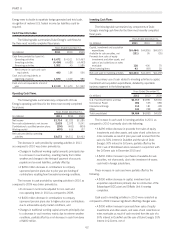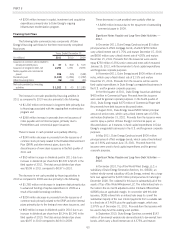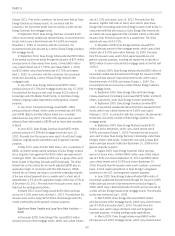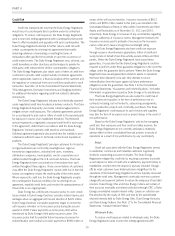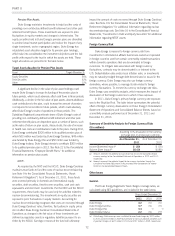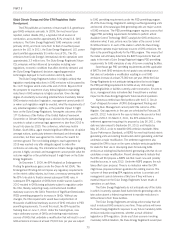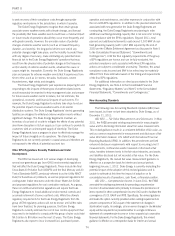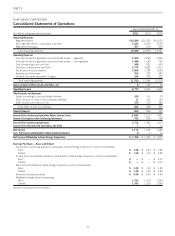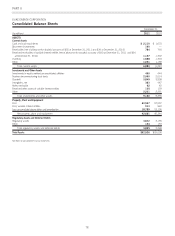Duke Energy 2011 Annual Report Download - page 91
Download and view the complete annual report
Please find page 91 of the 2011 Duke Energy annual report below. You can navigate through the pages in the report by either clicking on the pages listed below, or by using the keyword search tool below to find specific information within the annual report.
PART II
counterparties that permit the Duke Energy Registrants to offset
receivables and payables with such counterparties. The Duke Energy
Registrants attempt to further reduce credit risk with certain
counterparties by entering into agreements that enable the Duke
Energy Registrants to obtain collateral or to terminate or reset the
terms of transactions after specified time periods or upon the
occurrence of credit-related events.
European Exposures.
Duke Energy owns a 25% ownership interest in Attiki, a natural
gas distributor located in Athens, Greece. The carrying value of Duke
Energy’s investment in Attiki was $64 million at December 31,
2011, and is recorded in Other within Investments and other assets
in the Consolidated Balance Sheets. Duke Energy also has a $64
million debt obligation associated with its investment in Attiki. Duke
Energy has an agreement to sell its ownership interest in Attiki. If all
conditions of this agreement are met, Duke Energy expects the
transaction to close in March 2012. At December 31, 2011, Duke
Energy held $285 million of money market funds and short term
investments in investment-grade debt securities of issued by financial
and nonfinancial institutions that are domiciled in Europe or have
exposures to European sovereign debt. This amount is recorded at fair
value and included in Cash and cash equivalents and Short-term
investment in the Consolidated Balance Sheets. A disorderly default
by the Greek government or withdrawal of Greece from the euro zone
and financial stress in other European countries could require Duke
Energy to recognize an impairment of some or all of these securities.
Interest Rate Risk
The Duke Energy Registrants are exposed to risk resulting from
changes in interest rates as a result of their issuance of variable and
fixed rate debt and commercial paper. The Duke Energy Registrants
manage interest rate exposure by limiting variable-rate exposures to a
percentage of total capitalization and by monitoring the effects of
market changes in interest rates. The Duke Energy Registrants also
enter into financial derivative instruments, which may include
instruments such as, but not limited to, interest rate swaps,
swaptions and U.S. Treasury lock agreements to manage and
mitigate interest rate risk exposure. See Notes 1, 6, 14, and 15 to the
Consolidated Financial Statements, “Summary of Significant
Accounting Policies,” “Debt and Credit Facilities,” “Risk Management,
Derivative Instruments and Hedging Activities,” and “Fair Value of
Financial Assets and Liabilities.”
The table below summarizes the potential effect of interest rate
changes on the Duke Energy Registrants’ pre-tax net income, based
on a sensitivity analysis performed as of December 31, 2011 and
December 31, 2010.
Summary of Sensitivity Analysis for Interest Rate Risks
($ in millions)
Potential Increase (+)
or Decrease (-) in
Interest
Expense(a):
Assuming market
interest rates average
1% higher (+) or
lower (-) in 2012
than in 2011 As of
December 31, 2011
Assuming market
interest rates average
1% higher (+) or
lower (-) in 2011
than in 2010 As of
December 31, 2010
Duke Energy +/- $4 +/- $8
Duke Energy Carolinas +/- $5 +/- $2
Duke Energy Ohio +/- $4 +/- $1
Duke Energy Indiana +/- $9 +/- $5
(a) Amounts presented net of offsetting impacts in interest income.
These amounts were estimated by considering the impact of the
hypothetical interest rates on variable-rate securities outstanding,
adjusted for interest rate hedges, short-term and long-term
investments, cash and cash equivalents outstanding as of
December 31, 2011 and 2010. The change in interest rate
sensitivity for the Duke Energy Registrants’ is primarily due to
changes in short-term debt balances and cash balances. If interest
rates changed significantly, management would likely take actions to
manage its exposure to the change. However, due to the uncertainty
of the specific actions that would be taken and their possible effects,
the sensitivity analysis assumes no changes in the Duke Energy
Registrants’ financial structure.
Marketable Securities Price Risk
Duke Energy
As described further in Note 16 to the Consolidated Financial
Statements, “Investments in Debt and Equity Securities,” Duke
Energy invests in debt and equity securities as part of various
investment portfolios to fund certain obligations of the business. The
vast majority of the investments in equity securities are within the
NDTF and assets of the various pension and other post-retirement
benefit plans.
71



